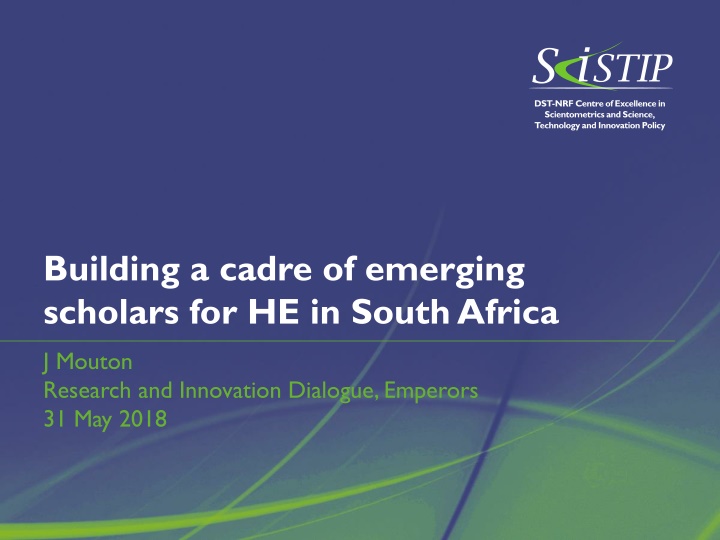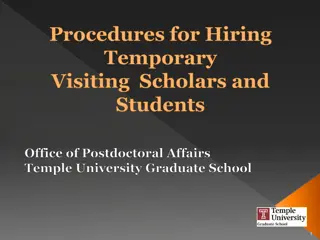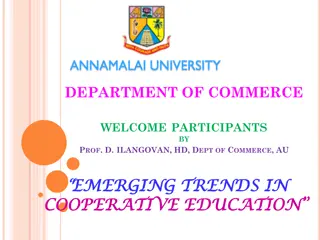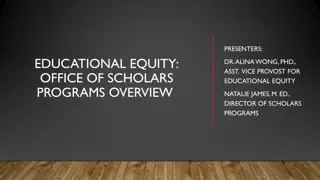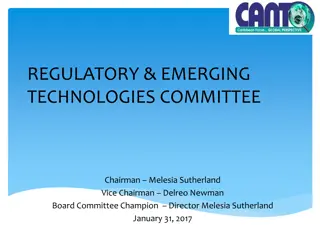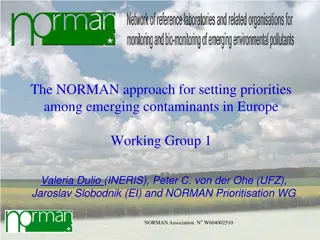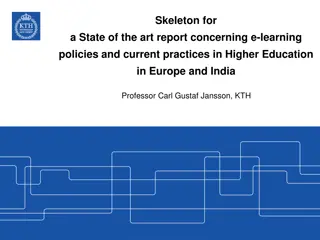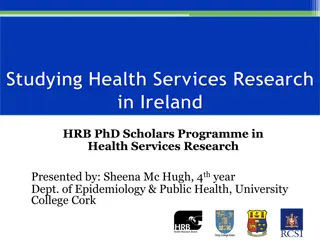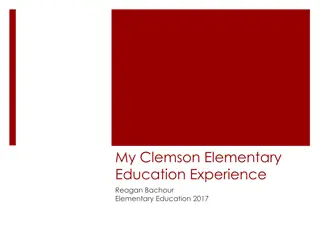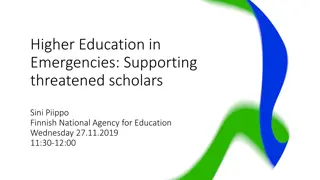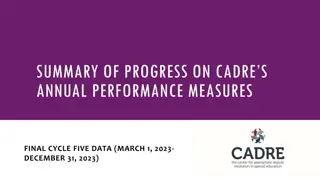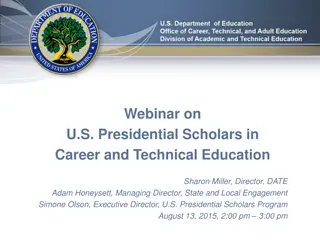Building a Cadre of Emerging Scholars in Higher Education
Support for emerging researchers in South Africa's higher education sector through initiatives like SARChI and CoEs. Identifying criteria for defining emerging scholars and setting study objectives for research activity levels among lecturers and senior lecturers.
Download Presentation

Please find below an Image/Link to download the presentation.
The content on the website is provided AS IS for your information and personal use only. It may not be sold, licensed, or shared on other websites without obtaining consent from the author.If you encounter any issues during the download, it is possible that the publisher has removed the file from their server.
You are allowed to download the files provided on this website for personal or commercial use, subject to the condition that they are used lawfully. All files are the property of their respective owners.
The content on the website is provided AS IS for your information and personal use only. It may not be sold, licensed, or shared on other websites without obtaining consent from the author.
E N D
Presentation Transcript
Building a cadre of emerging scholars for HE in South Africa J Mouton Research and Innovation Dialogue, Emperors 31 May 2018
On the notions of emerging scholars and the silent majority With flagship programmes such as the SARChI, CoEs and the bursary and scholarship programmes, significant strides have been made in supporting established researchers and the next generation of researchers (SARChI and CoEs include support for next generation researchers). Except for the Thuthuka programme, support for emerging researchers has not been at a significant scale despite the Department s recent efforts to recapitalize the Thuthuka programme. Owing to limited resources, inter alia, the footprint of emerging researchers programmes has been limited. Working with the DVCs of Research at HEIs, the DST has unearthed the silent majority in the higher education sector. This silent majority belongs to the emerging researchers pipeline and appears to largely comprise lecturers and senior lecturers in our universities.
USAF definition of emerging scholars Based on the study TOR, an operational definition of emerging scholar would include those academics at SA universities who are: typically 40 years and younger (AGE), would not have their PhDs yet (QUALIFICATION), would belong to the RANKS of lecturer or senior lecturer, AND would typically not be research active (MEASURE OF RESEARCH ACTIVITY). Taking these criteria as point of departure, the Terms of reference document then formulated the first main study objective (Overleaf)
First main study objective To establish the proportion and demographics of academics at lecturer and senior lecturer levels/all levels of the permanent instruction staff at Higher Education Institutions (HEIs) who are active researchers, as well as those who are not active researchers.
Four subsidiary objectives 1. To establish what the sector (HE) profile of lecturers and senior lecturers are in the system. 2. To establish what proportion of lecturers and senior lecturers are actively publishing (one meaning of research active ). 3. To establish what proportion of lecturers and senior lecturers are actively applying for funding (another meaning of research active ). 4. To establish what proportion of lecturers and senior lecturers are actively publishing AND applying for funding.
Subsidiary objective 1 To establish what the sector (HE) profile of lecturers and senior lecturers are in the system
Objective 1: National profile of Lecturers and Senior Lecturers (n = 12 686 out of 17 757) 975 5% 2200 12% 1890 11% Professor Associate professor Senior lecturer Lecturer Junior Lecturer 7940 45% 4746 27%
Gender profile of Lecturers and Senior Lecturers 3737 2639 (47%) (56%) 4205 2108 (53%) (46%) Senior lecturer Lecturer Female Male
Racial profile of Lecturers and Senior Lecturers 100% 90% 2885 (37%) 80% 2645 (57%) 70% 60% 769 (10%) 50% 655 (8%) 40% 390 (8%) 228 (5%) 30% 3511 (45%) 20% 1399 (30%) 10% 0% Senior lecturer Lecturer A C I W
Qualification profile of Lecturers and Senior Lecturers 100% 1458 (18%) 90% 80% 2643(56%) 70% 60% 50% 6484 (82%) 40% 30% 2104 (44%) 20% 10% 0% SNR Lect LECTURER Do not have a PhD Have a PhD
Headline finding Rank (No PhD) 40 years and younger 41 to 50 years old 51 60 years old 61+ years old Lecturers (n = 6 484) Senior lecturers (n= 2 104) 3150 710 1929 604 1186 618 219 172 If one were to apply the ToR criteria of AGE, RANK and QUALIFICATION we find the following: Out of the total number of 12 686 lecturers and senior lecturers 8 588 (or 68%) do NOT have a PhD. If we further disaggregate this group by age, we find that 3 860 are 40 years and younger. Is this group the real silent majority ? Or should one expand this group to include those between 41 and 50. years of age? This produces a total of 6 393 individuals. Of course, these numbers do not yet distinguish between research active or inactive academics.
Subsidiary objective 2 To establish what proportion of lecturers and senior lecturers are actively publishing (one meaning of research active )
Headline finding 2 Addressing the second research objective, required that CREST would find the Rank of academics and link this information to the Authors in our database of SA publications (SA Knowledgebase). On the basis of an analysis of the database we were able to estimate that approximately 2 000 senior lecturers can currently be classified as actively publishing (using a relatively weak measure of publication activity, i.e. at least one article unit in two years). In 2015, there were 4 746 senior lecturers at SA universities. This means that approximately 42% of senior lecturers could be categorised as actively publishing. Applying the same logic, we estimated that about 2 050 lecturers were actively publishing (again, using the same criterion). In 2015 there were 7 940 lecturers at SA universities. This meant that approximately a quarter (25%) could be categorised as actively publishing.
Headline finding Perhaps the most surprising aspect of these results was the low percentage of senior lecturers who we categorised as actively publishing : only 40 45% of senior lecturers were actively publishing when 56% of them had a PhD. This would suggest that most of those who we classified as actively publishing are those in possession of a PhD. This is a relationship that we have established from various previous studies. The bulk of academic publication continues to be produced by professors or associate professors at SA universities (90% of whom who are in possession of a PhD. At the other extreme, it is perhaps not surprising that only about 25% of lecturers were actively publishing, as only 18% of all SA lecturers had a PhD. Again, it is quite likely that those we classified as actively publishing are the same ones who have a PhD.
Subsidiary objective 3 and 4 What proportion of lecturers and senior lecturers are actively applying for funding to the NRF AND what proportion of lecturers and senior lecturers are actively publishing AND applying for funding.
Linking SAK authors to NRF funding data No of snr/ lecturers % Lecturers/Senior lecturers in CREST database with a valid year of birth Applied for or received funding No interaction with NRF No funding Received funding 3673 1133 2540 2686 987 31% 69% 73% 27% Of the 3673 names that CREST submitted to the NRF approximately one third (1 133 or 31%) applied for or received funding. The NRF could not link the names of the remaining 69% to any applications to the NRF. These names are classified in the table above as having no interaction with the NRF . Of the 1 133 who applied for funding, 987 received funding. Those who received funding from the NRF are subsequently classified into six funding categories: next generation, emerging, established, etc. It is important to take note that some researchers can be accounted for more than one category
Lect/Snr Lecturers receiving funding from NRF by funding instrument 2009 2010 2011 2012 2013 2014 2015 2016 2017 Total 97 102 95 90 105 76 95 98 118 124 52 65 76 110 134 8 11 20 23 26 44 49 87 67 119 115 174 164 31 149 107 199 217 35 153 83 208 270 51 127 58 206 1298 319 1407 58 122 852 Next generation Emerging Established Strategic Cross-cutting instruments Infrastructure 263 917 2 4 5 7 7 8 15 726 20 759 12 775 4817 80 279 326 381 415 515 641 TOTAL
Breakdown of 2017 recipients of NRF grants (SAK-linked) 12 2% The analysis of applications by senior lecturers and lecturers to the NRF has unfortunately not produced much clarity on the phenomenon of the silent majority. It seems as if the label silent majority has been incorrectly linked to rank of academic staff (senior lecturers and lecturers) in the ToR document. The NRF has indicated that the notion of an emerging scholar is not linked to the rank of the applicant, but to the call category of the application. The breakdown in the Figure on the right shows how the Lecturers/Senior Lecturers that could be linked to NRF-funding in 2017 are distributed across the funding instrument categories. Established 58 7% 58 7% Emerging 319 41% Cross-cutting instruments Next generation 122 16% 206 27% Strategic Infrastructure
So: Is there a silent majority? The matching of the CREST and NRF data allowed us to draw some more fine- grained conclusions. We could establish that only about one third of those senior lecturers and lecturers who we have classified as actively publishing have in fact applied to the NRF for funding over the past 10 years. This means that about 70% of all senior lecturers and lecturers at SA universities have not applied to the NRF in recent years. So there is indeed a silent majority of academics who do not access NRF funding. However, this group cannot be categorised as exclusively belong to the category of emerging scholars . It is quite clear that the interaction between rank, age and qualification is much more complex, and a simple equivocation with a label such as emerging scholar (a term which is itself not unambiguously defined) is not warranted.
Study objective 2 To investigate the environmental context, enablers and impediments to increasing the number of emerging researchers at systemic, institutional and individual levels. The second main objective of the study was addressed first through a web-based survey of SA academics, and subsequently with qualitative interviews with a select group who had completed the survey. The web- based survey was conducted between May and September 2017 and produced 3 210 complete and usable questionnaires. The qualitative interviews were conducted between September and November and resulted in 124 completed interviews.
Defining research active In the previous section we presented two operational measures of research active (publishing and applying for funding). The web survey that was conducted as part of addressing the second main question of the study allowed is to address this matter more directly. So we included in the survey a set of questions that aimed at establishing whether survey participants had, in the previous five years, engaged in any of a number of research related activities. Their responses were used to construct an index of research activity. The table overleaf presents a list of the statements that were used in constructing this index.
An index of research activity In the past five years I have Participated in one (or more) research project(s) Been the principal investigator of a research project Completed a research-based qualification Published one (or more) journal article(s) in DHET approved journals Published one (or more) peer-reviewed book(s) Published one (or more) peer-reviewed book chapter(s) Presented research at one (or more) conference(s) Supervised the research of one (or more) honours students Supervised the research of one (or more) masters students Supervised the research of one (or more) doctoral students Successfully applied for NRF funding Unsuccessfully applied for NRF funding Successfully applied for other research funding (other agencies besides the NRF, own university, international donor) Unsuccessfully applied for other research funding Completed performances, productions or exhibitions arising from creative work in my field Completed plans, designs, patents or software arising from my research or professional activity in my field Advised on the research projects of colleagues Peer-reviewed one (or more) journal or book contribution(s) Yes 1 1 1 1 1 1 1 1 1 1 1 1 weight 1 2 2 2 4 2 1 1 2 3 2 1 2 No 0 0 0 0 0 0 0 0 0 0 0 0 N/A 0 0 0 0 0 0 0 0 0 0 0 0 1 0 0 1 1 1 0 0 1 0 0 1 1 0 0 1 1 1 1 0 0 0 0
Criterion validation of IRA What is your current rank or position? Junior Lecturer Lecturer Senior Lecturer Associate Professor Professor Senior Professor Mean N Std. Deviation 3.80 5.54 7.01 8.57 8.98 9.11 117 1022 678 289 293 2.130 2.336 2.433 1.813 1.895 1.572 Being research active seems to correlate with RANK 61 Mean N Whether highest qualification is a PhD Std. AND with having a PHD Deviation PhD Not PhD 7.89 4.50 1685 1121 2.208 2.158 Mean N Age cohort with 40 cut-off point 40 years and younger 41 years and older Total Std. Deviation 2.652 BUT not with AGE 6.11 1058 6.91 6.59 1568 2626 2.724 2.724
Five sub-groups for analyses Using a set of criteria (age, qualification, rank and score on activity index) enabled us to create five subgroups from our survey sample. Group A: The emerging young scholars (Inactive, young lecturers/senior lecturers without a PhD) Group B: The active young scholars (Active lecturers and senior lecturers) Group C: The active older scholars (Lecturers and senior lecturers only) Group D: The under-qualified older scholars (Lecturers and senior lecturers only) Group E: Established, active scholars (Professoriate)
Five sub-groups for analysis (n=2185) Active young scholars (PhD) Active older scholars (PhD/Lect/Snr Lect) Active established senior scholars (PhD/ Professors) (n = 548 or 25%) 7 on IRA (n = 365 or 17%) (n = 469 or 21%) Emerging young scholars (no PhD) Under-qualified older academics (no PhD) 6 on IRA (n = 427 or 20%) (n = 376 or 17%) 40 years and younger 41 years and older
Headline Finding What motivates academics to do research? In response to a set of questions aimed at establishing what motivates SA academics to undertake research, we found that the five most frequently reported motivations (>95%) concerned two main dimensions: making a contribution to the greater good (a field or society), and (re)generating one s own expertise, research skills and field-specific knowledge. Creating opportunities for, and collaborating with, others is also a strong impetus, as is the more inward-directed sense of achievement from publication, and the time-honoured motivation for science, i.e. satisfying one s curiosity.
Motivations for research Responses by total sample (descending order of motivation rated) 99% Contribute to my field 98% Build my expertise 97% Develop/improve my research skills 97% Contribute to society 96% Stay current in my field 95% Experience a sense of achievement from publication 95% Create opportunities for others (e.g. students or 95% Collaborate with others 93% Satisfy my curiosity 89% Become the best in my field 86% Achieve peer recognition 84% Attend conferences 83% Build an impressive CV 79% Get promoted 74% Satisfy performance appraisal requirements 74% Receive DHET subsidy for publications 71% Increase my income 56% Get respect/admiration from students 52% Find a better job elsewhere 40% Get a reduced teaching load
Motivations for research Motivations more specific to emerging and young scholars 84% 80% 80% 80% 80% 78% 78% 76% 66% 62% 49% 48% 45% 42% 28% A - Emerging scholars B - Active, young researchers C - Active, older (snr) lecturers D - Under-qualified, older (snr) lecturers E - Established, active scholars Receive DHET subsidy for publications Get a reduced teaching load Satisfy performance appraisal requirements
Motivations for research Motivations more specific to emerging and young scholars 93% 88% 87% 83% 82% 80% 75% 70% 60% 59% 56% 53% 51% 51% 34% A - Emerging scholars B - Active, young researchers C - Active, older (snr) lecturers D - Under-qualified, older (snr) lecturers E - Established, active scholars Find a better job elsewhere Increase my income Get promoted
Headline Finding Criteria for academic promotion The majority of academics (two-thirds or more) perceived all aspects of research as important for promotion at their university. Supervision of postgraduate (particularly master s students) and publishing in WoS- indexed journals (especially those with high impact factors) emerged as the most important with approximately 9 in 10 respondents identifying these aspects as such. Slightly lower percentages of respondents (80 87%) considered it important to publish in SA journals (on the DHET list of approved journals), to deliver presentations at international conferences, to engage in NRF-related activities (i.e. obtaining a rating and applying for funding from the foundation), and to apply for other (non-NRF) grants. Ranked relatively (and similarly) low within the context of promotion were service to the university and stakeholder and community engagement, as well as (unsurprisingly) the teaching of undergraduate students.
Criteria for academic promotion Ratings of importance (total sample) 91% Supervising and delivering Masters graduates 90% Publications in journals that are indexed in the Web 89% Supervising and delivering PhD graduates 87% Publications in journals with high impact factors 84% Publications in South African journals on the DHET 83% Presentations at international conferences 83% Applying for NRF research grants or funding 83% Obtaining an NRF rating 80% Applying for other research grants (industry, 71% Service to the university (e.g. contribution to 68% Teaching undergraduate students 66% Stakeholder and community engagement
Criteria for academic promotion Sub-group comparisons D - Under- qualified, older (snr) lecturers E - Established, active scholars A Emerging scholars B - Active, young scholars C - Active, older (snr) lecturers ITEM Supervising and 'delivering' PhD graduates Applying for other research grants (industry, government, international donors etc.) Publications in journals that are indexed in the Web of Science of Thomson Reuters ('ISI journals') Applying for NRF research grants or funding 78% 95% 96% 80% 98% 74% 84% 87% 71% 82% 85% 96% 94% 80% 96% 79% 90% 88% 75% 83% Obtaining a NRF rating 78% 89% 87% 78% 87% Supervising and 'delivering' Masters graduates Service to the university (e.g. contribution to committees) Publications in South African journals on the DHET list of approved journals Stakeholder and community engagement 86% 94% 95% 89% 95% 67% 71% 75% 68% 71% 90% 78% 88% 93% 74% 67% 59% 64% 68% 63% Teaching undergraduate students 74% 69% 66% 68% 65% Presentations at international conferences 81% 80% 82% 83% 83% Publications in journals with high impact factors 88% 90% 89% 87% 87%
We need a differentiated approach to performance appraisal: differentiate according to stage of academic career A number of interviewees made a plea that universities should have more differentiated approaches to performance appraisal as the illustrative quotes below show. Even for example our KPAs and our whole performance management system, it is completely skewed for sort of young lecturers. The goals are completely ridiculous, meaningless, and no one even, no one reaches it. So, we honestly ignore them now. So, you would need to have, I don't know, a separate metrics for emerging scholars compared to the profs and maybe a little more transparency on how all the funds are distributed. [M,W,31,L,UP] it would also be important to look at where is the staff member at, in terms of their academic development. And allow for that to speak to performance contracting. If I am busy with my PhD, my contracts would focus on my development and progress on that PhD. Once I am done with the PhD, then my contract should look at my publishing, what am I doing after that. Rather than to have a combination of both whilst I am working on my PhD. That creates a conflict. When it suits my line, they want me to publish. When it suits them, they want the PhD progress. And that is creating a lot of havoc within the system. [M,B,45,L,UJ]
Ive told myself I just want to finish my PhD and look for a job somewhere else. Where I ll teach what I teach and with dignity. And in a very human way. Because I think what I ve been going through is too ... dehumanising. Barriers to research (career)
Headline Finding Barriers to research (career) One of the main aims of the study was to ascertain what the main barriers are that emerging scholars experience as far as their careers are concerned. It is remarkable that large proportions of all subgroups of our study identified many and similar barriers to their careers. Large proportions of all subgroups indicated that the lack of sufficient time for research, heavy administrative loads, heavy involvement in university administration and lack of money for research are barriers to their research. It is clear that these barriers or challenges affect all academic staff equally seriously, irrespective of rank and age and qualification.
Barriers to research (career) Responses by total sample (descending order of barrier experienced) 85% Insufficient time for research 84% Heavy administrative workload 72% Heavy undergraduate teaching workload 71% Heavy involvement in departmental/faculty/university 67% Postgraduate students who are not prepared for post-graduate 66% Lack of money for research activities 65% Lack of a conducive research environment 61% Heavy postgraduate teaching / supervision workload 55% Lack of research networks 53% Lack of mentors or role models 50% Lack of support from head of department/faculty/centre 43% Lack of access to research infrastructure or equipment 38% Lack of self-confidence 30% Lack of support from home/social environment 26% Non-completion of (own) PhD 15% Lack of affordable childcare 12% Taking maternity/parental leave
Sub-group comparisons Common barriers: Time (workload), research environment/ funding for research 100% 90% 80% 70% 60% 50% 40% 30% 20% 10% 0% Insufficient time for research Heavy administrative workload Heavy undergraduate teaching workload Lack of a conducive research environment B - Active, young researchers Lack of money for research activities A - Emerging scholars C - Active, older (snr) lecturers D - Under-qualified, older (snr) lecturers E - Established, active scholars
Sub-group comparisons Barriers more specific to emerging and young scholars compared to established scholars 69% 65% 63% 62% 61% 60% A - Emerging scholars 56% 54% B - Active, young researchers 37% C - Active, older (snr) lecturers D - Under-qualified, older (snr) lecturers E - Established, active researchers 27% Lack of mentors or role models Lack of research networks
Sub-group comparisons Barriers related to PG supervision and PG studies 89% 86% 83% 80% 77% 72% 55% 49% 49% 47% Heavy postgraduate teaching / supervision workload Postgraduate students who are not prepared for post- graduate studies A - Emerging scholars C - Active, older (snr) lecturers E - Established, active scholars B - Active, young researchers D - Under-qualified, older (snr) lecturers
Sub-group comparisons Barriers related to personal and social factors 47% 44% 40% 39% 38% 36% 31% 29% 25% 24% 22% 21% 20% 19% 15% 13% 8% 8% 7% 6% A -Emerging scholars B - Active, young scholars C - Active, older (snr) lecturers D - Under-qualified, older (snr) lecturers E - Established, active scholars Lack of self-confidence Lack of affordable childcare Lack of support from home/social environment Taking maternity/parental leave
Main barriers to the advancement of research: Heavy teaching and administrative loads Teaching impossibly large numbers of undergraduate students leaves no time for research. The range of teaching, supervisory, administrative and other professional service-rendering tasks were perceived as an increasing burden on the individual academic and led to a palpable sense of frustration. The huge burden of administrative tasks and the accompanying bureaucratic red tape led to academics questioning the meaning of what they were to do (compliance culture rather than an academic culture). Performance demands set by management (the demands to meet certain pass rates and throughput rates) further reinforced a culture of compliance rather than a culture of excellence. The implications of working with academically underprepared students for the range of skills required from the academic were clearly expressed many interviews.
Division of labour according to rank One of the factors that were cited by emerging or early-career academics as a constraining factor in the advancement of their careers, was their academic workload. More precisely, they claimed that they were usually assigned disproportionately high teaching loads (especially at the undergraduate levels), as well as often inordinate administrative duties. There seems to be a practice at some universities that junior staff should bear the brunt of undergraduate teaching to allow senior staff to focus on research and produce as many publications as possible to earn subsidy income for the university I was told that if I thought the job was teaching that I was in the wrong job environment because it s not about teaching
Publication hurdles A number of difficulties related to publishing were highlighted in the interviews. Interviewees noted that they required assistance in identifying appropriate publication avenues (journal impact factor, rating, etc.), a lack of methodological preparedness to publish in internationally accredited journals, as well as trouble obtaining journal fees. It is worth noting that these concerns were expressed by interviewees from academics at the top research universities in the country, as well as historically disadvantaged institutions.
Lack of mentors/ lack of research networks ITEM A Emerging young scholars B Active young scholars C Active older scholars D Under- qualified older academics E Active established senior scholars Heavy undergraduate teaching workload Lack of a conducive research environment Lack of mentors or role models Lack of research networks Non-completion of (own) PhD 89% 89% 81% 90% 59% 78% 65% 64% 70% 51% 68% 54% 51% 63% 29% 65% 64% 59% 60% 37% 63% 3% 4% 66% 1%
1 1. Intensify . Intensify efforts to lecturers and lecturers to obtain doctoral degrees lecturers and lecturers to obtain doctoral degrees efforts to enable enable higher proportions of senior higher proportions of senior The biggest structural barrier to increasing the number of active, emerging scholars in the SA Higher Education system is the fact that very low percentages of senior lecturers and lecturers are in possession of a doctorate degree. The average percentage of SA academics with a doctorate remains low (55%) and has not increased significantly over the past five years. The NDP has set a target of 75% of SA academics being in possession of a doctorate by 2030. Given recent trends, it is clear that this target will not be achieved. It is imperative that the universities intensify their efforts to support larger numbers of their lecturers and senior lecturers to obtain doctoral degrees and they design and implement innovative interventions to achieve this. 63% of emerging scholars in survey indicated that the non- completion of their PhD s is the major barrier to their research career
2 2. . Universities should be encouraged to adopt more Universities should be encouraged to adopt more differentiated research performance appraisal criteria for differentiated research performance appraisal criteria for emerging scholars emerging scholars Our study has found evidence of a growing sense of disillusionment and even cynicism amongst younger scholars about the pervasive research performance management culture at SA universities. Although the majority of emerging scholars accept that they have to comply with a system that measures every aspect of their academic work, there is a growing sense of unhappiness about the all-pervasive and undifferentiated nature of this system amongst some academics. The current near-exclusive emphasis on research and graduate outputs should be reconsidered and universities and other relevant stakeholders (such as DHET and NRF) should be encouraged to adopt more differentiated academic and research performance criteria.
